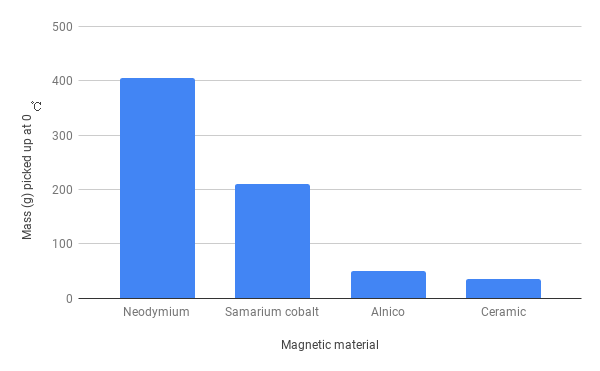Factors Affecting Magnetic Strength Formative Assessment
The force that a magnet exerts on certain materials, including other magnets, is called magnetic force. Several factors affect the strength of magnetic force, including temperature and distance.
Experiment 1
Students measured the effect of temperature on magnetic force by cooling a magnet and then measuring the mass of iron the magnet could pick up at 8 different temperatures ranging from 0 to -21.3 ℃. The results are shown in Table 1.
Temperature (℃) | Weight attracted (g) |
-21.3 | 275 |
-19.4 | 273 |
-18.1 | 265 |
-15.3 | 263 |
-13.7 | 260 |
-6.7 | 245 |
-4.6 | 220 |
-1.7 | 215 |
0 | 212 |
Experiment 2
Different materials have different magnetic properties. To determine the magnetic force of neodymium magnets, students measured the mass of iron a neodymium magnet could pick up at 0 ℃. They repeated this procedure for similar sized samarium cobalt, alnico, and ceramic magnets. The results are shown in Figure 1.

The image is a bar graph showing the relative strengths of four magnets, each made from a different material. The x-axis is the magnet category with a bar for neodymium, samarium cobalt, alnico, and ceramic. The y-axis is the mass, in grams, the magnets picked up at zero degrees Celsius. The values of the bars are 405 grams for neodymium, 210 grams for samarium cobalt, 50 grams for alnico, and 35 grams for ceramic.
1. If the scientists in Experiment 1 tested the magnet at -24.0 ℃, how much weight could the magnet attract?
2. Based on Table 1 and Figure 1, what type of magnet was tested in Experiment 1?
3. Based on the description of Experiment 2, what is the most likely question the students were trying to answer?